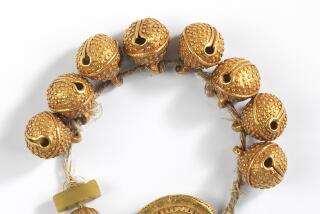Germany’s updated military museum is an arsenal for dissent
Atop a hill overlooking a city still rebuilding after its near-destruction more than 65 years ago stands a once-staid former armory now slashed in half by a giant shard of glass and steel.
The Museum of Military History in Dresden, redesigned by the American architect Daniel Libeskind and set to open to the public Saturday, is the first war museum to open in Germany since the country’s reunification and a study in contrasts appropriate to a nation grappling with its violent past.
The radical $85-million overhaul of the museum, run by the Bundeswehr, the German armed forces, has drawn criticism from all sides, civilian and military alike, with some complaining of excessive antiwar sentiment, some of insufficient attention to the victims of organized violence, and others simply of misguided aesthetics.
Central to the controversy, and the new museum, is the 99-foot, 14,700-ton wedge of steel and glass that cuts through the old arsenal like an enormous piece of shrapnel. The museum was one of the few major buildings to survive the February 1945 firebombing of Dresden by Allied forces, which leveled 80% of the city, and to some of its residents, its dramatic bisection by the modernist wedge is a step too far.
But Libeskind believed that the museum could make itself relevant only with a sharp turn from its orderly past. “He couldn’t imagine housing a reflection on the history of the German military in a conventional rectangular building,” said Jochen Klein, Studio Daniel Libeskind’s project leader for the museum, during a press preview this week.
The museum was built in 1873 as a military arsenal. Over the next 120 years, it served as the army museum for Saxony, as a Nazi military museum and as the museum of the East German National People’s Army, until it was taken over by the Bundeswehr after reunification in 1990. Before it was closed for reconstruction 10 years ago, the museum presented German military history in a straightforward chronological manner — “very old-fashioned, very unspectacular,” said Barbara Holzer of the architecture firm Holzer Kobler, which helped design the institution’s interior.
In its latest incarnation, the museum has a split approach: chronological in the old building and thematic in the new wedge. The Libeskind addition presents such topics as “War and Suffering” and “Fashion and the Military” as well as displays that include a taxidermied lion and camel, a Nazi-era piano, a hanging Alouette helicopter, old army underwear and more missiles than you can count. But its highlight is at its peak, which points toward the sky from which the Allied bombs rained down. There, visitors are treated to a spectacular view of the city, which, like the museum, is a peculiar combination of the old (prewar buildings) and new (modern construction).
Among the striking elements of the exhibits are the combining of the world wars into the awkward “1914-1945” section of the old building. There is no exhibit about the Holocaust.
Hans Günter Merz — chief architect at the German firm HG Merz Architects and Museum Designers, which along with Holzer Kobler planned the institution’s interior — argued, “German historians say that the period between 1914 and 1945 was the second Thirty Years War, because it didn’t stop in between.”
Merz acknowledged that there would be criticism of the lack of space dedicated to the Holocaust. “That will certainly come,” he said.
Falk Jaeger, an architecture critic and historian in Berlin, agrees with Merz’s assessment. “You can’t accuse the Germans of sweeping the Holocaust under the rug,” he said. “There are memorials in every city. I don’t think you need to do it in this museum too. It’s a military museum.”
Throughout the exhibits, it’s clear that the museum’s planners and directors tried to avoid taking sides. Nowhere is this more evident than on the top floor of the wedge, which has a damaged piece of a wall from the Dresden firebombing. If left to stand alone, it could have served as a powerful reminder of German suffering in the war. Instead, it’s counterbalanced by ruins from German bombing attacks on Rotterdam, the Netherlands, Coventry, England, and Wielun, Poland.
“We didn’t want to focus on a victimization perspective,” Holzer said. “That’s dangerous.”
Concurrent with his work on the Dresden museum, Libeskind — who is known in Germany for his equally striking and angular design of Berlin’s Jewish Museum — has also been in charge of the master plan for ground zero in New York. Although his role in the design of the 1 World Trade Center tower there became less prominent, he retained full control of the Museum of Military History.
Libeskind has responded to the reaction of people who find the renovated museum jarring by portraying the redesign as necessary to advance the conversation on war in Germany.
“I wanted to create a bold interruption, a fundamental dislocation, to penetrate the historic arsenal and create a new experience,” Libeskind said in a statement. “The architecture will engage the public in the deepest issue of how organized violence and military history and the fate of the city are intertwined.”
The museum ends up being a strange hybrid: a military museum with a moderately antiwar bent, housed in a structure that combines the conventional and the strikingly modern, overlooking a city stuck between its bloody past and its rapid modernization.
Col. Matthias Rogg, the museum’s director, says this unique combination is possible in a country only with such complex and conflicting attitudes toward the military: “This museum could only exist in Germany, because our history in the 20th century is so stark.”
More to Read
The biggest entertainment stories
Get our big stories about Hollywood, film, television, music, arts, culture and more right in your inbox as soon as they publish.
You may occasionally receive promotional content from the Los Angeles Times.






